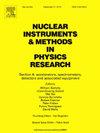制造和测试用于检测高能伽马的具有 30 个气隙的 3D 双层 RPC
IF 1.5
3区 物理与天体物理
Q3 INSTRUMENTS & INSTRUMENTATION
Nuclear Instruments & Methods in Physics Research Section A-accelerators Spectrometers Detectors and Associated Equipment
Pub Date : 2024-10-09
DOI:10.1016/j.nima.2024.169969
引用次数: 0
摘要
多隙电阻板室(MRPC)是一种高性能、高性价比的探测器。它们易于制造,可覆盖大面积区域。它们具有出色的时间分辨率和潜在的空间分辨率。在此背景下,我们制作了一个具有 15 层双层叠加层(30 个气隙)、无视差误差的三维 RPC。所设计的 RPC 具有二维像素化读出功能,地面电极上的感应电荷可提供三维位置。模拟结果表明,在 X-Y 平面上,511 千伏伽马射线的半最大全宽(FWHM)分辨率约为 70 μm,而在垂直于探测器平面的 Z 轴上,空间分辨率约为 560 μm。在信噪比为 17 的情况下,间距为 6.25 毫米的拟议探测器的填充因子约为 0.13%,而在相同设置和信噪比为 42.5 的情况下,可实现的最大填充因子约为 23%。针对准直铯-137 点源测得的探测器空间分辨率与模拟结果十分吻合。对于距离 RPC 探测器 0.95 厘米的各向同性 511 千伏伽马源,在 1900V 电压下,RPC 的实验探测效率约为 2.1%,相对误差为 7%,与 GEANT4 的模拟结果(2.25%)十分吻合。使用相同的探测器,在伽马源距离探测器(临床 PET 照相机)较远的情况下,探测效率约为 5.09%。对于使用 18F 点源的小型动物 PET(半径 100 毫米),由像素尺寸为 2.25∗2.25 毫米2 和 1∗1 毫米2 的三维 MRPC 探测器组成的 PET 系统的空间分辨率(Γ)分别为 1.64 毫米和 0.91 毫米,这些探测器采用商业印刷电路板技术(间距 = 6.25 毫米)和微光刻技术(间距 = 1.25 毫米)制造。本文章由计算机程序翻译,如有差异,请以英文原文为准。
Fabrication and testing of a 3D double-stack RPC with 30 gas gaps for detection of high energy gammas
Multigap Resistive Plate Chambers (MRPCs) are cost-effective detectors with a high-performance. They are easy to build and offer the possibility to cover large areas. They provide excellent time resolution and potentially good spatial resolution. In this context, a 3D RPC with 15 double-stack layers (30 gas gaps) free of parallax error is fabricated. The designed RPC has a 2D pixelated readout and the induced charge on the ground electrodes, gives the position in the third dimension. The simulation results show that in the X–Y plane the Full Width Half Maximum (FWHM) resolution is around 70 μm for 511 keV gammas, while for the Z-axis, which is perpendicular to the detector plane, a spatial resolution of around 560 μm can be achieved. The fill factor of the proposed detector with a pitch of 6.25 mm for SNR of 17 is around 0.13%, and the maximum achievable fill factor for the same setup and SNR of 42.5 is around 23%. The measured spatial resolution of the detector for a collimated Cs-137 point source is in good agreement with the simulation results. For an isotropic 511 keV gamma source at 0.95 cm distance of RPC detector, the experimental detection efficiency of constructed RPC at 1900V applied voltage is around 2.1%, which with a relative error of 7% is in good agreement with the simulation result obtained by GEANT4 (2.25%). With the same detector, at larger distances of the gamma source from the detector (clinical PET camera) a detection efficiency of around 5.09% is achievable. For small animal PET (100 mm radius) with 18F point source, the spatial resolution (Γ) of a PET system composed by 3D MRPC detectors with 2.25∗2.25 mm2 and 1∗1 mm2 pixel sizes, fabricated by commercial PCB technology (pitch = 6.25 mm) and Microlithography technology (pitch = 1.25 mm), would be 1.64 mm and 0.91 mm, respectively.
求助全文
通过发布文献求助,成功后即可免费获取论文全文。
去求助
来源期刊
CiteScore
3.20
自引率
21.40%
发文量
787
审稿时长
1 months
期刊介绍:
Section A of Nuclear Instruments and Methods in Physics Research publishes papers on design, manufacturing and performance of scientific instruments with an emphasis on large scale facilities. This includes the development of particle accelerators, ion sources, beam transport systems and target arrangements as well as the use of secondary phenomena such as synchrotron radiation and free electron lasers. It also includes all types of instrumentation for the detection and spectrometry of radiations from high energy processes and nuclear decays, as well as instrumentation for experiments at nuclear reactors. Specialized electronics for nuclear and other types of spectrometry as well as computerization of measurements and control systems in this area also find their place in the A section.
Theoretical as well as experimental papers are accepted.

 求助内容:
求助内容: 应助结果提醒方式:
应助结果提醒方式:


